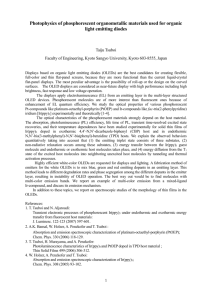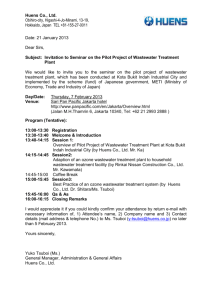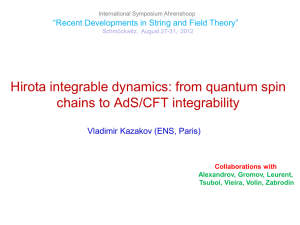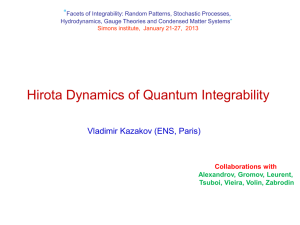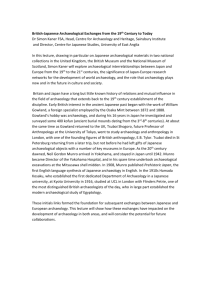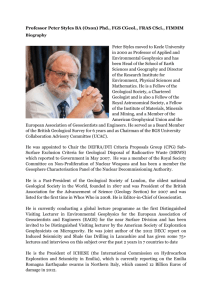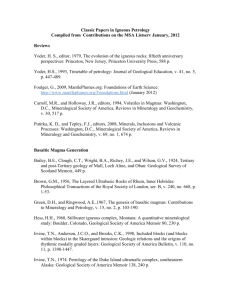here - The Pacific Circle
advertisement
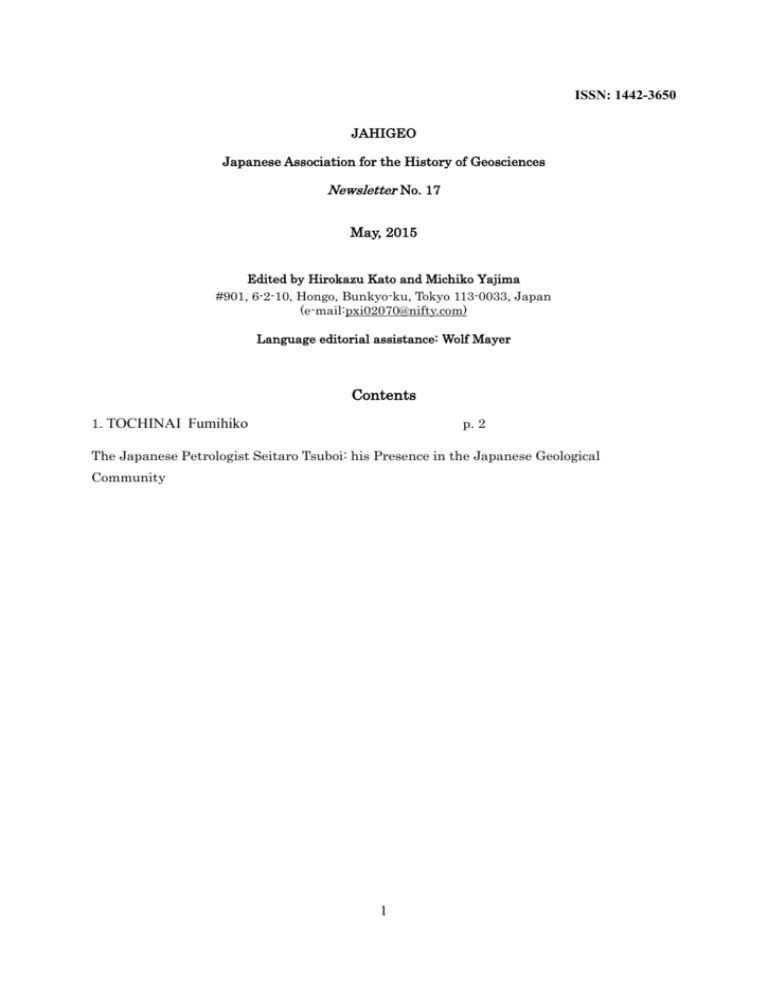
ISSN: 1442-3650 JAHIGEO Japanese Association for the History of Geosciences Newsletter No. 17 May, 2015 Edited by Hirokazu Kato and Michiko Yajima #901, 6-2-10, Hongo, Bunkyo-ku, Tokyo 113-0033, Japan (e-mail:pxi02070@nifty.com) Language editorial assistance: Wolf Mayer Contents 1. TOCHINAI Fumihiko p. 2 The Japanese Petrologist Seitaro Tsuboi: his Presence in the Japanese Geological Community 1 The Japanese Petrologist Seitaro Tsuboi: his Presence in the Japanese Geological Community 1 Fumihiko Tochinai* 1. Introduction In this article, I shall focus on the geologist, more precisely, the petrologist, Seitaro Tsuboi (18931986) (see Figure 1), who exercised a considerable influence on the course of Japanese geological sciences. Although his name is not widely known, he was one of a number of highly influential persons in the Japanese scientific community. Not only did he lead the Japanese geological community as a professor of geology at Tokyo Imperial University, which was renamed the University of Tokyo in 1947, from the 1920s to 1950s but, until the 1970s, he also played an important role in the Japanese scientific community at large. In countries like Japan, where many natural disasters take place, the geological sciences play an essential and practical role in daily life; geological scientists calculate the probability of severe earthquakes, evaluate the safety of buildings and the land in the event of earthquakes, and so on. In this regard, the geological sciences have a direct connection to our daily life; and therefore, historical study of the geological sciences in Japan will Figure 1. A portrait of Seitaro Tsuboi at the age of 27. (Figures 1, 2 and 3 are taken from the Tsuboi Materials, likely provide us with interesting viewpoints on the about which see the last section of this article.) subject of 'science in and/or for society.' Seitaro Tsuboi was born in 1893 as the eldest son of Shogoro and Naoko Tsuboi. Immediately after his * 1 Kanazawa Institute of Technology. E-mail: tochinai@neptune.kanazawa-it.ac.jp This article is based on my presentation "The Japanese Petrologist Seitaro Tsuboi and his Presence in the Japanese Geological Community" at the 39th INHIGEO Conference, Asilomar, July 2014. The research on Tsuboi conducted from April 2012 to March 2015 (including the presentation) is supported by JSPS Kakenhi Grant No. 24650583. As for Tsuboi, also see the following articles: Fumihiko Tochinai, "The Methodological Aspect of the 'Historicity Controversies' in the Japanese Geological Community after World War II: The Change of Attitude to Physicochemical Methods before and after the War", Historia Scientiarum, vol. 12-1, 2002, pp. 59-73.; Fumihiko Tochinai, A Study of the Japanese Geological Community in 1950~60s --- Influence on Three Factors on the Controversies on Physicochemical Approaches ---, A thesis presented to the faculty of the Division of Physics, Graduate School of Science, Hokkaido University for the Doctorate Degree, 2005. 2 graduation in 1917 from the Department of Geology, Faculty of Science, Tokyo Imperial University, he was appointed assistant professor of the Department. In 1921, after his promotion to associate professor, he started studying in the USA, the UK and Germany. Two years later, he returned to Japan to succeed his mentor, Bunjiro Koto, as head of the Department, a position he held for 30 years (as a full professor from 1928), until his retirement at the age of 60, in 1954. Considering the hierarchical structure of the Japanese academic community in those days, the head of the Department was also regarded as the leader of the entire Japanese geological community. The Tsuboi family included many scholars: Shogoro Tsuboi (1863-1913), his father, was a founder of anthropology in Japan, his grand and great-grand father were scholars of Western medicine in the late and the last Edo period. On his mother's side, his uncle, Dairoku Kikuchi (1855-1917) had held the position of President of Tokyo Imperial University and had served as Minister of Education. His brother, Chuji Tsuboi (1902-1982) was a geophysicist. As a member of the Tsubois, his influence reached beyond the field of the geological sciences, and lasted into the 1970s. 2. Interest in Bowen's Theory as the "New Petrology" Tsuboi's major achievement in petrology in Japan was the introduction of the theory of igneous petrogenesis, developed by N. L. Bowen (1887 - 1956), but with his own refinements based on his deep understanding of microscopic petrography. Since his high school days, Tsuboi had been attracted to petrological studies that applied experimental methods, such as the optical analysis of minerals with polarizing microscopes, melting experiments of rocks, and so on. Such developments were regarded by him as the "new petrology," in which the Geophysical Laboratory of the Carnegie Institution of Washington (GPL) played an essential role. As a member of GPL, Bowen had systematically conducted melting experiments from 1910, to test for the chemical equilibriums of various rock minerals. These experiments led him to develop the idea of the "reaction principle" which demonstrates that the various types of igneous rocks were formed from a few types of primary Figure 2. The Evolution, a complimentary copy from magmas, such as basaltic magma, by the process of Bowen. 3 crystallization-differentiation. Bowen’s 1922 paper on the "reaction principle"2 attracted the attention of many petrologists. However it was not until 1928 that he finally published The Evolution of the Igneous Rocks3 (see Figure 2). His theory has played so important a role in modern petrology that "modern igneous petrology would be unthinkable without the overarching genius of Norman Levi Bowen"4. The introduction of the "new petrology" to Japan was initiated by scholars who were about 10 years senior to Tsuboi. He, who influenced him most, was Shukusuke Kozu (1880-1955), professor of petrography at Tohoku Imperial University, who had studied at GPL from 1913 to 1916. After his return to the University, Kozu and his pupils devoted themselves to "new petrology" researches. At that time, a science magazine, Gendai-no Kagaku (Science Today), was popular among high school students, to which Kozu's pupils contributed articles to introduce the latest research trends in European and American scientific communities. Influenced and attracted by these, Tsuboi went to Tokyo Imperial University in 1914 to learn about the "new petrology". He had been reading reports by GPL members "always with a special interest ... and began to think about a methods that would link Bowen's theory with the facts of real igneous rocks."5 In 1922, during his studies abroad, Tsuboi met Bowen at GPL and established friendly relations with him. For the next 10 years, Tsuboi focused on research in igneous petrogenesis and published Kaseigan Seiin-ron [Theory of Igneous Petrogenesis] in 19326. Although it followed Bowen's theory, Tsuboi's Kaseigan Seiin-ron was never a rehash of The Evolution. Firstly, Tsuboi was conducting cutting-edge research, as Bowen was doing. For example, in his letter to Tsuboi dated 31 December 1926, Bowen wrote, "I have just read your paper on 'Genetical Interpretation of Extrusive Rocks' in the Kotô Commemoration Volume. ... It is of much interest to me to find that we have independently arrived at similar results. It gives me greater Figure 3. A letter from Bowen to Tsuboi, dated 31 confidence in my conclusions regarding the December 1926. N. L. Bowen, "The Reaction Principle in Petrogenesis", The Journal of Geology, vol. 30 (3), 1922, pp. 177198. 3 N. L. Bowen, The Evolution of the Igneous Rocks, Princeton University Press, 1928. 4 Davis Young, N. L. Bowen and Crystallization-Differentiation: The Evolution of a Theory, The Mineralogical Society of America, 1998, p. 253. 5 Seitaro Tsuboi and Fukutaro Hori, "Magumaron-no ayumi --- Zasshi 'Kagaku' soukan-no omoide-ni furetsutsu [The Progress of Magmatic Theories --- Recalling the Publication of a Science Magazine 'Kagaku'---]", Kagaku, 50 (12), 1980, p. 755. 6 Seitaro Tsuboi, Kaseigan Seiin-ron [Theory of Igneous Petrogenesis], Iwanami Shoten Publishers, 1932. 2 4 Hebridean rocks..."7 (see Figure 3). In The Evolution, Bowen referred to this in a footnote on page 94; he wrote "It may be of interest to note that this part of the discussion takes a quite similar form to a discussion of the same factors by Tsuboi, though it was written before Tsuboi's paper was seen." 8 Secondly, in combining this work with his method of the optical analysis of rocks, Tsuboi could add more details to Bowen's arguments. Tsuboi had been attracted to rock analysis by use of the polarizing microscopes since his student days. During his studies abroad, he had published two papers on the chemical compositions of plagioclase in Mineralogical Magazine, London9. In Chapter 7 of Kaseigan Seiin-ron, Tsuboi proposed the employment of his optical method to trace the sequence of crystallization from magma to rocks10. Seeking quantitative and precise methods to determine the reaction series of minerals, Tsuboi paid attention to the change of the optical characteristics of minerals as a function of the stages in their crystallization. For example, at the time it had already been known that in the feldspar series (from calcic plagioclase to potash feldspar), the minerals that formed in the earlier stages of crystallization were richer in anorthite (and poorer in albite) than minerals formed in the later stages. The anorthite-albite ratio can easily and precisely be determined with the polarizing microscopes, by evaluating the difference between refractive indices. Applying his knowledge and skills of optical analysis, Tsuboi refined Bowen's theory. Tsuboi's Kaseigan Seiin-ron was published in 1932 as a part of Iwanami Shoten Publishers' series "Geology and Paleontology, Mineralogy and Petrology," whose authors had been considered to be leading scholars in their respective fields of research. It suggests that Tsuboi was regarded as one of leading figures in his field. In 1934, the Japan Imperial Academy awarded Tsuboi the Imperial Prize for his "study on the genesis of igneous rocks." 11 These facts suggest that Tsuboi's research on igneous petrogenesis had received certain recognition in his days. 3. Influence on the course of Japanese geology after World War II Whether he positively or negatively influenced key persons in Japanese geology, such as Kenzo Yagi (1914-2008), Akiho Miyashiro (1920-2008), Hisashi Kuno (1910-1969), Masao Gorai (1916-2002), Shoji Ijiri (1913-1999) and others, Tsuboi had set the course of the Japanese geological community after World War II. Yagi and Miyashiro evaluated Tsuboi's research in a positive way. Yagi, professor of petrology at Tohoku University and Hokkaido University, entered Tohoku Imperial University in 1935 to study petrology under Kozu, where he read Kaseigan Seiin-ron so often that the spine of the book broke12. Miyashiro, a pupil of Tsuboi, later became a professor at the State University of New York at Albany, where his research on A letter from N. L. Bowen to Seitaro Tsuboi, 31 December 1926. A photocopy of the letter was attached to the back cover of The Evolution which was presented by Bowen. 8 N. L. Bowen, op. cit. n. 3, p. 94. Including this, Bowen referred to Tsuboi's works three times on pages 94, 122 and 124. 9 Seitaro Tsuboi, "Optical Dispersion of Three Intermediate Plagioclases", Mineralogical Magazine, London, 20, 1923, pp. 23-107.; Seitaro Tsuboi, "A Dispersion Method of Determining Plagioclases in Cleavage-Flakes", Mineralogical Magazine, London, 20, 1923, pp. 107-122. 10 Seitaro Tsuboi, op. cit. n. 6, pp. 111-127. 11 Kanpo [The Official Gazette], no. 2147, 1 March 1934, p. 11. 12 Interview with Dr. Kenzo Yagi, at Dr. Yagi's residence in Sapporo, Japan, 20 July 2000. 7 5 metamorphic rocks flourished and contributed to the formulation of the theory of plate tectonics. However, the fact that Tsuboi's research had received certain recognition in his days does not necessarily mean that they were accepted. While some geologists were attracted to Tsuboi's research, Kuno and Gorai had rather mixed views. Kuno had been a pupil and was Tsuboi’s successor; however, there seemed to be some tensions between them. Gorai was initially charmed with Tsuboi's research, but he gradually became skeptical. In his autobiography, Gorai recalled, "Professor Tsuboi's Kaseigan Seiin-ron attracted me to this field [of igneous petrology]. ... It was quite modern ... and I felt like studying it further. ... But the further I studied, the more I started to feel that something didn't fit in ... Bowen's theory is clearly organized, but I wondered if it [Tsuboi’s work] too much simplified its complex nature."13 Ijiri, paleontologist and geologist, was a champion of those who were against Tsuboi. His antipathy was rooted in his ideology; he embraced leftist thinking. From his point of view, Tsuboi's research style was not only that of a bourgeois (in Marxist contexts), but also methodologically wrong in its application to the geological sciences. Ijiri was a founding member of Chidanken (Association for the Geological Collaboration in Japan). Since its foundation in 1947, Chidanken has had significant influence on the geological sciences in Japan. Ijiri and other founding members sought ways to give Chidanken the status of a youth group of the Geological Society of Japan, so that they could reform the Society's traditional hierarchic establishment. Many younger geologists including "grass-roots geologists" (local school teachers, university students and so on) 14 joined Chidanken; the number of members had reached about 1,500 by 196515. The Chidanken's strategy in trying to capture them was to put emphasis on the necessity of democratizing the geological community and on the "historicity" of geology; both of which have an affinity to leftist thinking. At the time, not a few scholars in Japan had sympathy with leftist thinking. A so-called red purge policy under the occupation of Allied Forces boosted the pro-Soviet atmosphere as a counter-reaction to anti-US ambience. In this context, due to the following two reasons, Ijiri regarded Tsuboi as a worthy opponent. Firstly, there had been tension between the old generation of researchers, such as Tsuboi, and younger researchers. When Tsuboi was young, it was matter-of-course for him to support his mentor as if he were his servant; therefore he naturally required his pupils, Kuno for example, to do the same. However, younger researchers did not accept such customs. Approaching his retirement after World War II, the transition of power from Tsuboi to Kuno began to favor the latter; at the same time as Chidanken was founded. Therefore, Tsuboi became a symbol of the "prewar undemocratic research system." Secondly, in order to appeal to "grass-roots geologists," Chidanken had not only put emphasis on Masao Gorai, "Kaseiron-no 40-nen --- Bowen-gakusetsu-tono Tatakai --- (sono 1) [40 Years of Igneous Petrogenesis Theories --- Fight against Bowen's Theory --- part 1", Chikyu Kagaku [Earth Science], 28 (3), 1974, pp. 253-255. 14 The expression "grass-roots geologist" is borrowed from an article by Shigeru Nakayama, "Grass-Roots Geology: Ijiri Shoji and the Chidanken", Science and Society in Modern Japan (The MIT East Asian Science Series), The MIT Press, 1974, pp. 270-279, in which he wrote on p. 270, "[Chidanken] serves as a meeting place for 'grass-roots geologists,' the typical member being a provincial teachers college graduate now teaching in a primary or secondary school." 15 Data is taken from Association for the Geological Collaboration in Japan, Kagaku Undo [Movements in Scientific Community], Tsukiji Shokan, 1969 (1st et. 1966). For reference, the number of members of the Gological Society of Japan at that time was about 2,000. 13 6 educational activities but also encouraged collaborative research by stressing the "historicity" of geology. "New petrology" often requires large-scale and expensive instruments as well as advanced knowledge of physics and chemistry; therefore it was difficult for "grass-roots geologists" to conduct this type of research. Inevitably, they tended to become involved in more descriptive research such as field surveys and microscopic observations. Chidanken claimed that the history of geological materials could be established in local research subjects by careful and minute observations; the more descriptive the research, the more detailed the history that would emerge from their studies (e.g. of rocks, strata, fossils, etc.). Then it would not be university scholars, such as Tsuboi, but local "grass-roots geologists" who would contribute more to geology as they would have a better knowledge of local geology. Does Tsuboi's influence still remain in today's geological community in Japan? It is difficult to evaluate this objectively. It seems to me, however, that traces of his influence can still be found. On one hand, when we try to criticize people and facts connected to Tsuboi, including Ijiri, "historicity," Chidanken etc., it creates an atmosphere of tension. An example is the discord created by attempts to change the name of a medal awarded by the Geological Society of Japan. The "Geological Society of Japan Medal" is the highest honor that can be awarded to non-member researchers (mainly non-Japanese). In the latter half of 1998, the Society proposed to change the name to the "A. Miyashiro Medal." The proposal met with serious opposition from some Chidanken members at the 1998 general assembly16. The Society finally decided to halt discussion on the subject, which has since been regarded as if it were a sort of taboo. On the other hand, it has allowed Chidanken to place great importance on the popularization of the earth sciences (in order to attract more "grass-roots geologists"). It is possible to say that Chidanken has made progress in terms of advancing scientific communication and public understanding of science. Chidanken's efforts in paying attention to the interests of the general public should be seen in a positive light. 4. Concluding Remarks Since 2010, I have studied a large quantity of historical materials relating to Seitaro Tsuboi (here referred to as "Tsuboi Materials"), which have been collected and archived in the Multi-media and Socioinformation Studies Archive, in the University of Tokyo. The materials, including Tsuboi Materials, have been collected from Tsuboi's residence in 2004, as part of a project of the University. These were then clustered and classified under the heading of each Tsuboi family member and, except for most of the Tsuboi materials they were digitally archived by 201117. As of the summer of 2010, some of the Tsuboi materials had been classified and stored with metadata in the library of the University; others have been kept in storage. Over about four and a half years, I prepared an inventory of the latter, to evaluate their value as historical materials, which has been transferred to the Tsukuba Research Department of the National Museum of Nature and Science, in December 2014. See the following issues of Geological Society of Japan News: 2 (2), 1999, p. 35; 2 (5), 1999, p. 23; 2 (9), 1999, pp. 11-17; 2 (11), 1999, p. 25; 4 (12), 2001, p. 25. 17 The digital archive, Digital Cultural Heritage, is created and maintained by Interfaculty Initiative in Information Studies, University of Tokyo. The url is: http://crarc.iii.u-tokyo.ac.jp/web/?locale=en#tab1 16 7 From 1935 to 1945, Tsuboi was Director-General of this Museum where, during World War II, he made an effort to preserve specimens. After he retired from the position, Tsuboi seemed to give his heart to the Museum; therefore, the Museum is the best facility to store Tsuboi Materials. Detailed studies of Tsuboi Materials can be expected. Acknowledgments I duly appreciate Dr. Wolf Mayer's language assistance and Dr. Michiko Yajima's useful comments on my research on the Tsuboi Materials. 8
